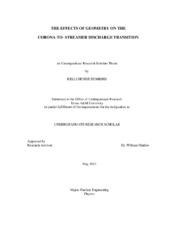| dc.description.abstract | The electric spark discharge has been studied for hundreds of years, yet many details of the phenomenon remain elusive. One particular area in the field of spark discharges that has yet to be explored in depth is the transition region between the corona and the streamer discharge. The parameters that characterize the transition region are purely geometric for a given potential difference applied between two electrodes. For the case of a point-to-plane electrode geometry, the transition between the oscillating corona discharge and the rapidly-growing streamer discharge is determined by the radius of curvature of the anode. In this contribution, the transition radius of curvature is found analytically using simplified models of each discharge and the principle of least action. For a sufficiently small anode, the corona discharge is also shown to be energetically more favorable at all radii of curvature, supporting the general claim that corona discharges are most readily produced on thin wires. | en |


